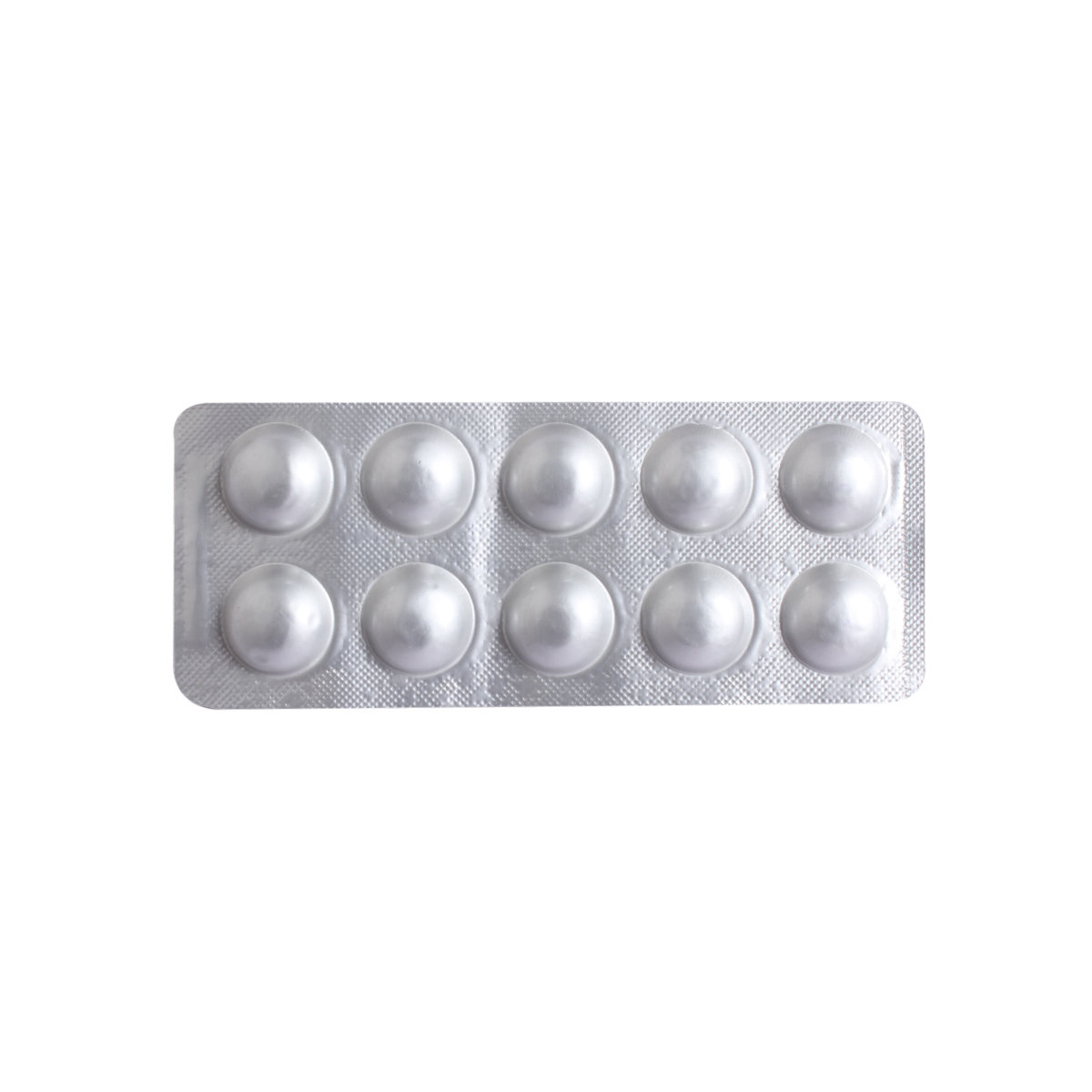CTD-M 6.25/50 Tablet 10's
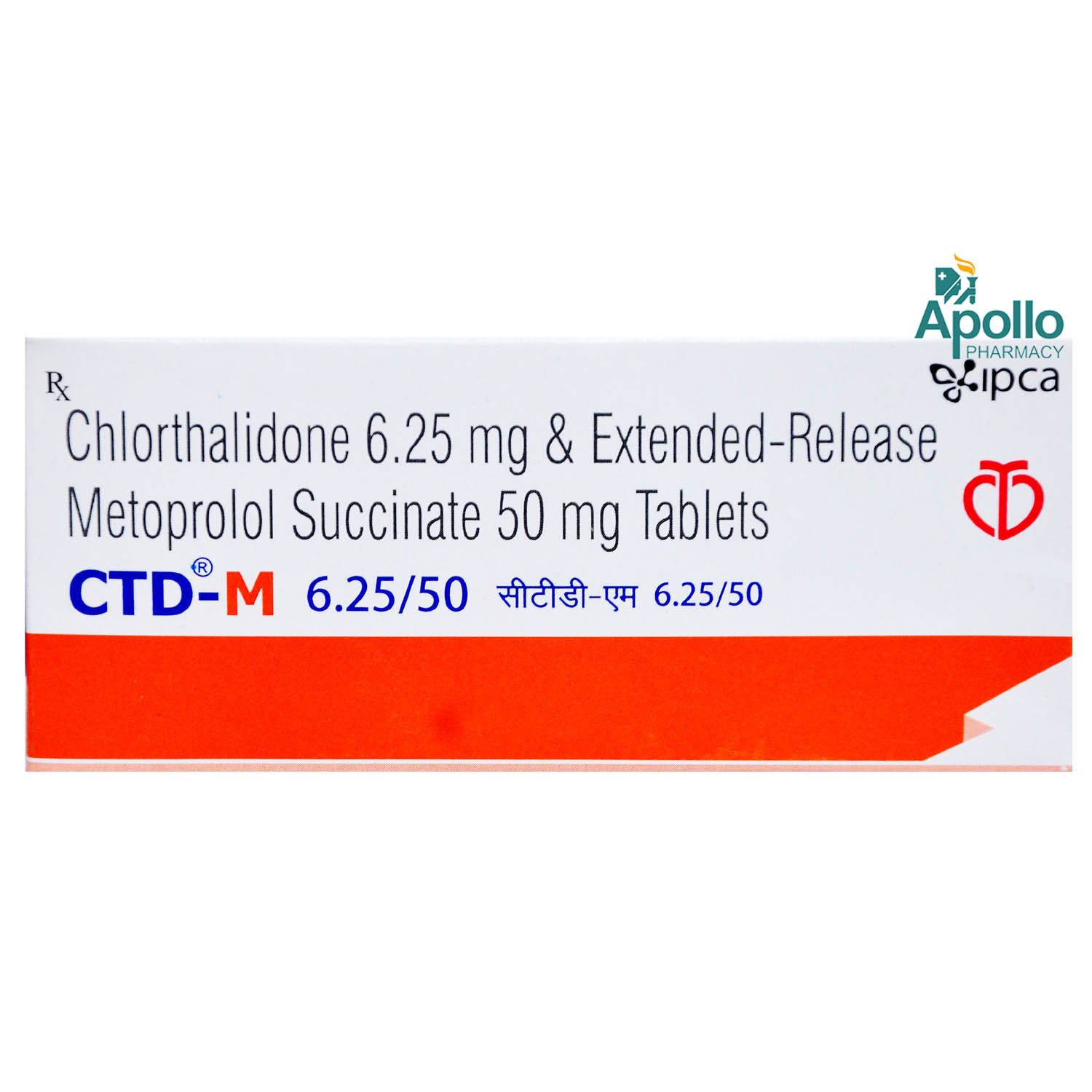
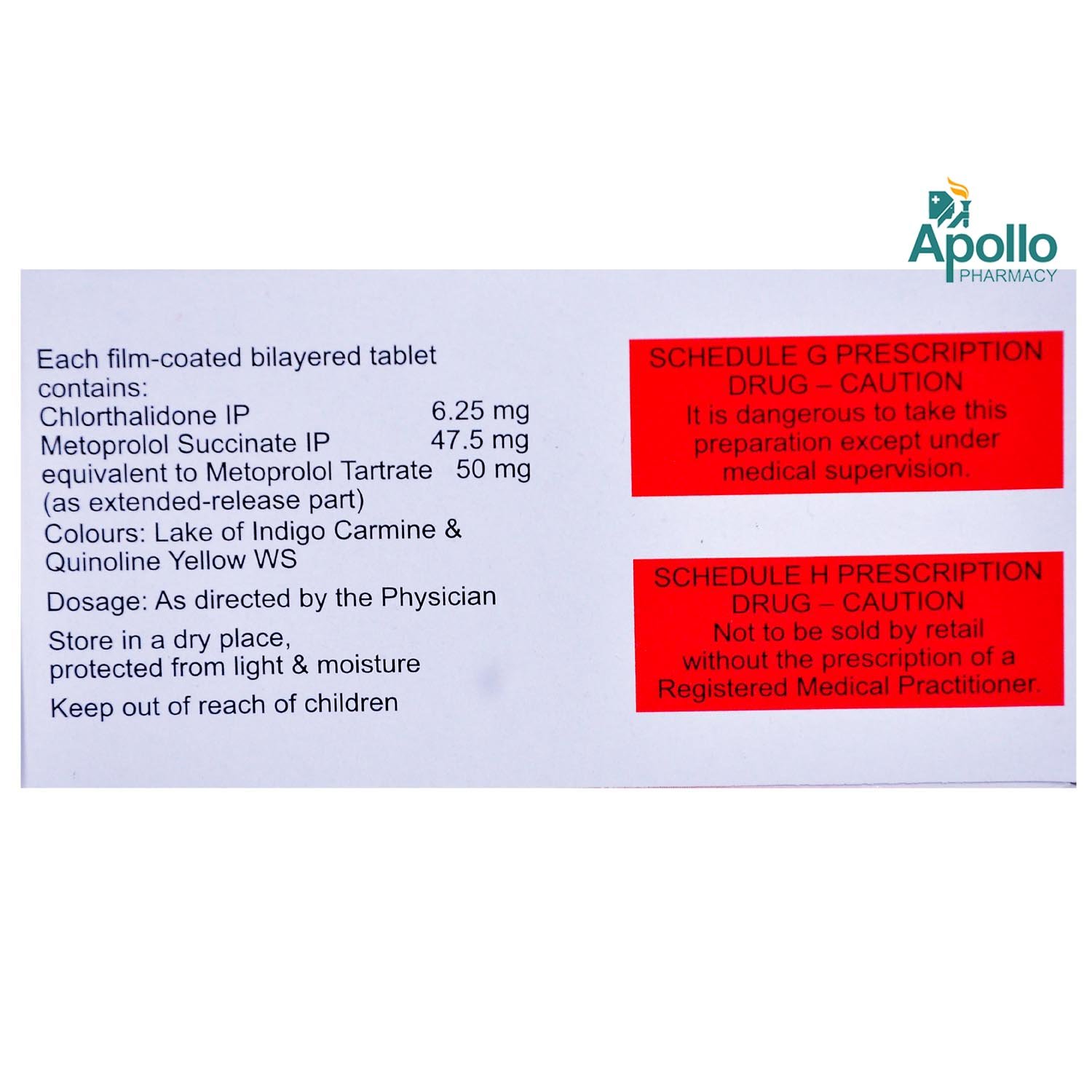
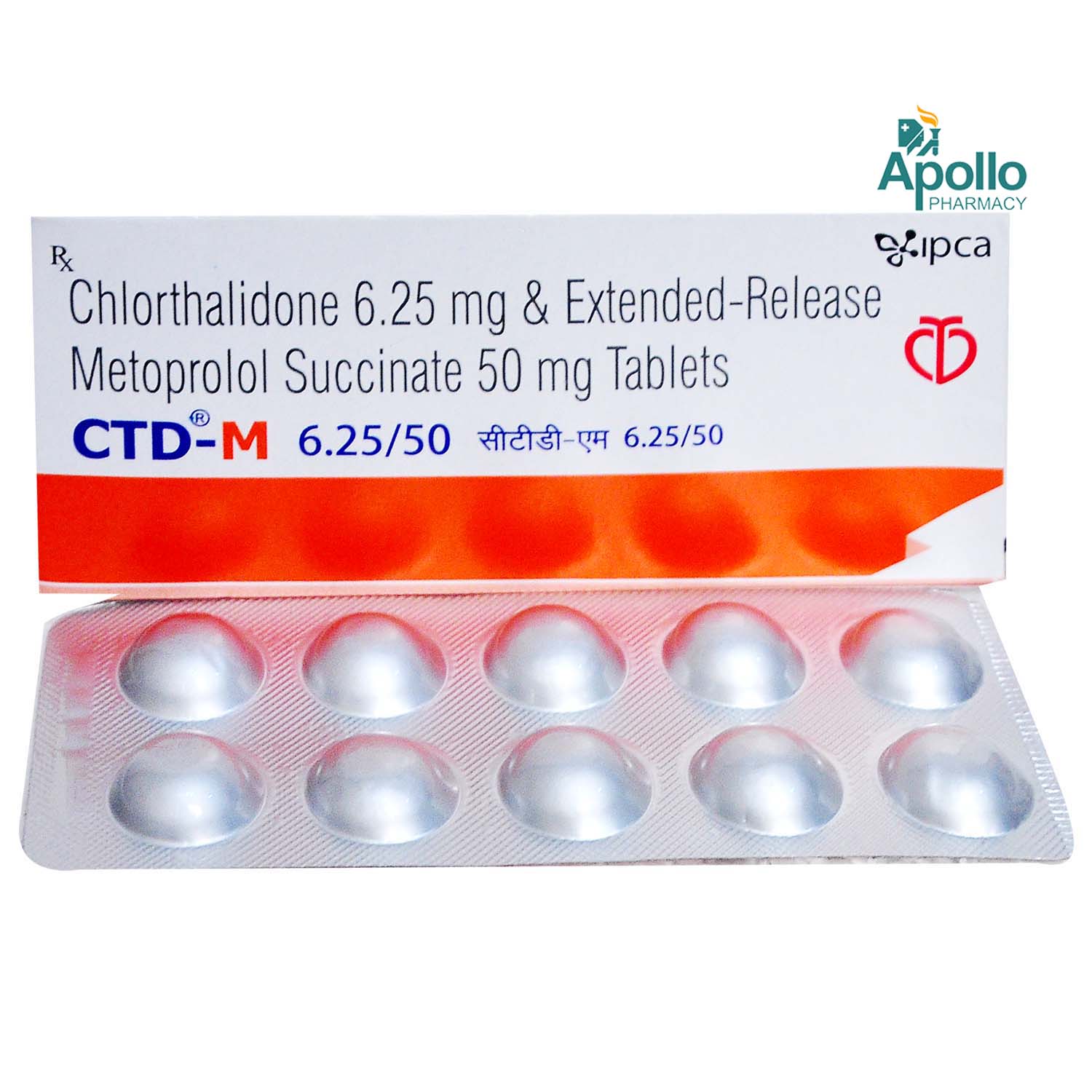
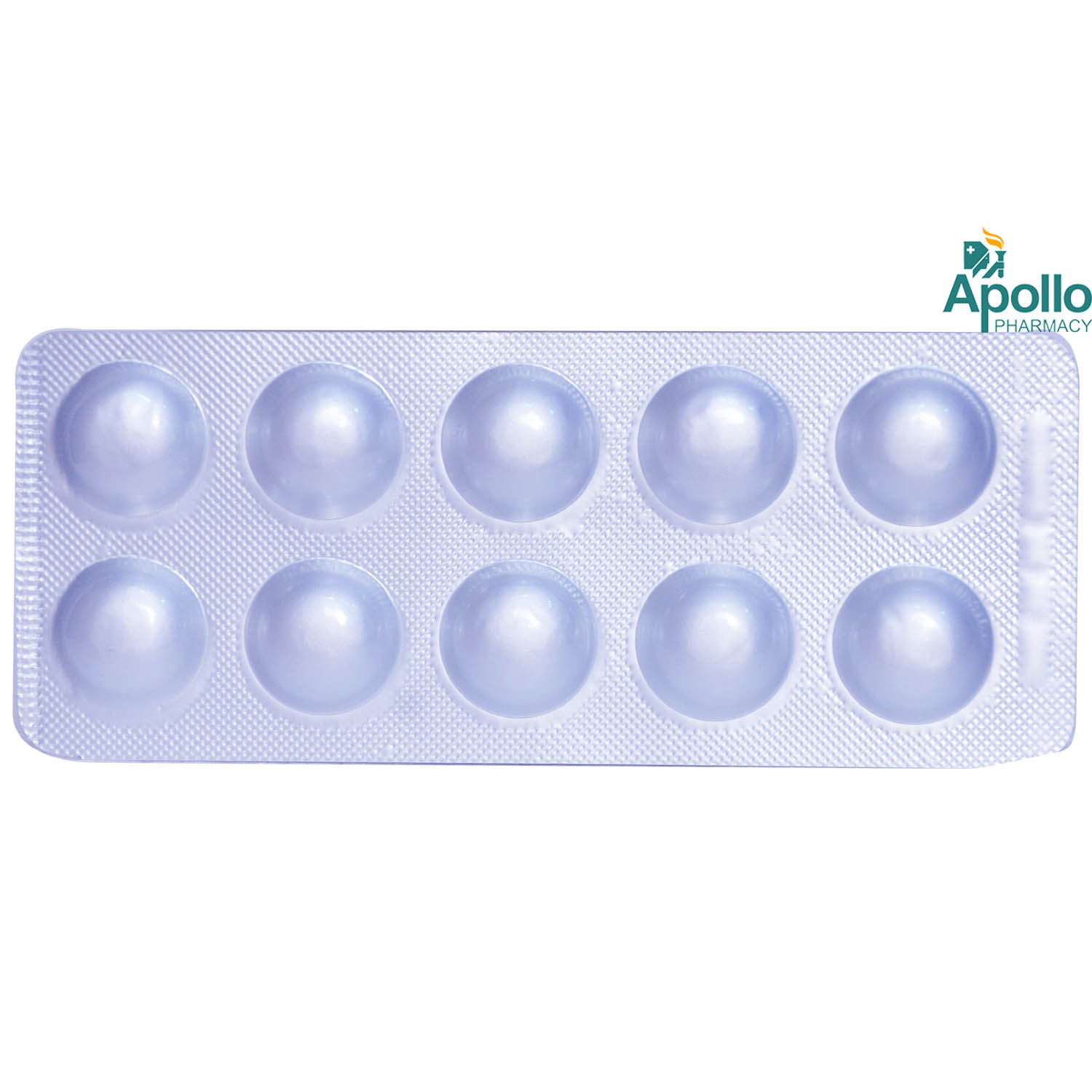
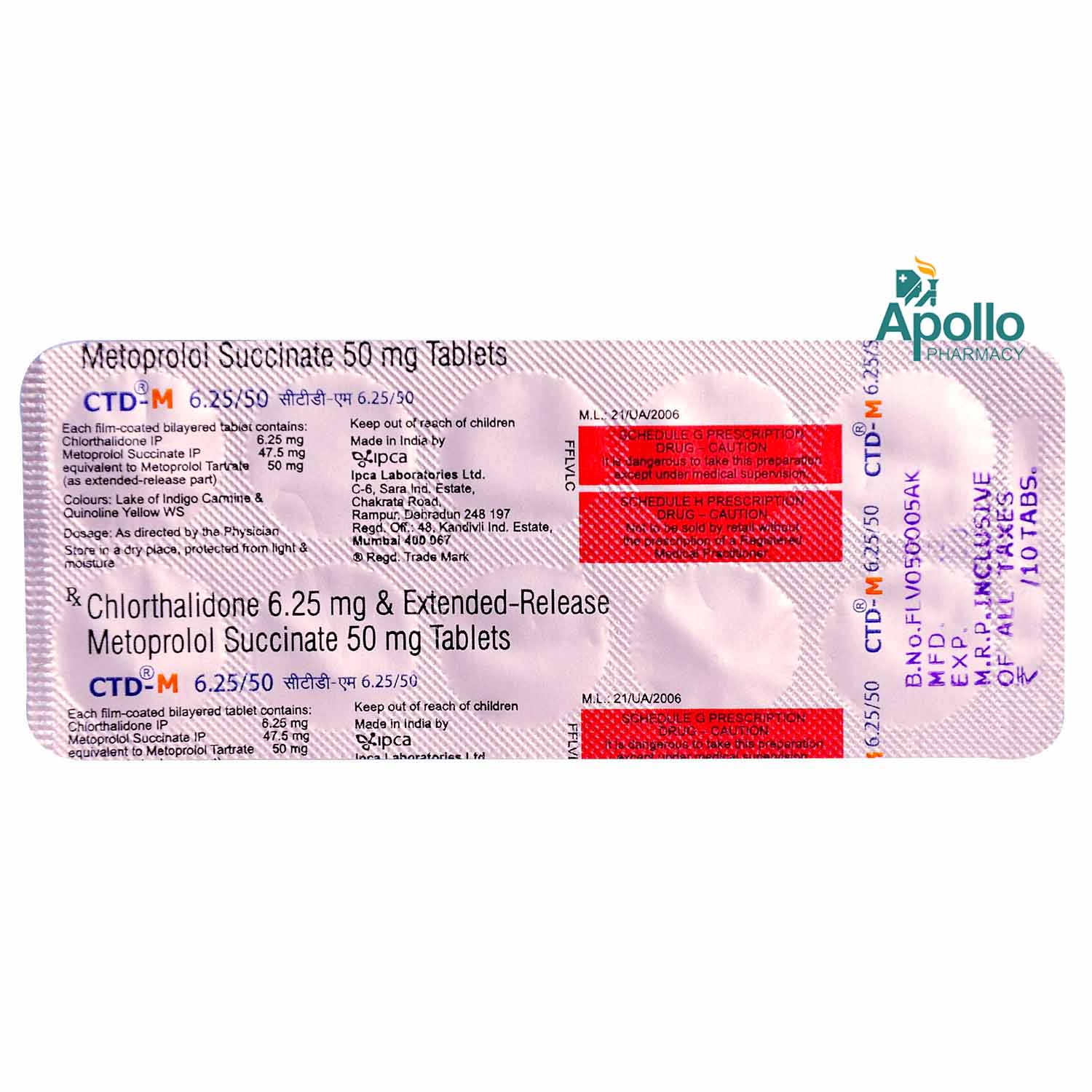





MRP ₹141.5
(Inclusive of all Taxes)
₹21.2 Cashback (15%)
Provide Delivery Location
Online payment accepted
 Prescription drug
Prescription drugWhats That
Composition :
Manufacturer/Marketer :
Consume Type :
Return Policy :
Expires on or after :
About CTD-M 6.25/50 Tablet
CTD-M 6.25/50 Tablet belongs to a group of medications called ‘antihypertensives’ used to treat hypertension (high blood pressure). It can also reduce oedema (fluid retention) in hypertensive patients. Hypertension is a condition in which there will be a persistent rise in blood pressure levels. This condition can also cause fluid retention, leading to peripheral oedema (swelling of legs and hands).
CTD-M 6.25/50 Tablet is a combination of two medicines: Metoprolol and Chlorthalidone. Metoprolol is a beta-blocker and works by blocking epinephrine, resulting in a decrease in heart rate and blood pressure. Chlorthalidone is a diuretic or water pill that acts by expelling excess water and salt from the body. It helps in decreasing fluid accumulation and oedema.
You should take this medicine as prescribed by your doctor. CTD-M 6.25/50 Tablet may cause some side-effects such as anorexia (loss of appetite), nausea and vomiting, diarrhoea, constipation, jaundice (yellowing of the whites of eyes and skin), dizziness, headache, visual abnormality, photosensitivity (sensitivity to light), orthostatic hypotension (dizziness on standing due to low blood pressure), weakness, restlessness, bradycardia (slow heart rate), and stomach pain. It may also electrolyte levels. If any of these side-effects persist, consult your doctor immediately.
Do not take CTD-M 6.25/50 Tablet if you are allergic to any contents of it. Do not take CTD-M 6.25/50 Tablet if you have heart rhythm problems, heart failure, blocked blood vessels, bradycardia (slow heart rate), chest pain, metabolic acidosis (increased acidity in the blood), and hypotension (low blood pressure). CTD-M 6.25/50 Tablet should be used with caution in patients with kidney or liver diseases, allergy or asthma, and gout (increased uric acid levels in the blood). Also, inform your doctor if you are pregnant and breastfeeding.
Uses of CTD-M 6.25/50 Tablet
Directions for Use
Medicinal Benefits
CTD-M 6.25/50 Tablet is a combination of two medicines: Metoprolol and Chlorthalidone. Metoprolol is a beta-blocker and works by acting on epinephrine, a hormone that can increase heart rate and blood pressure. So, blocking the action of epinephrine can result in a decrease in heart rate and blood pressure. Chlorthalidone is a diuretic or water pill that acts by expelling excess water and salt from the body. It helps in decreasing fluid accumulation and swelling or edema.
Storage
- If you experience low blood pressure symptoms like dizziness, lightheadedness, or fainting while taking medication, seek immediate medical attention.
- Make lifestyle modifications and adjust your medication regimen under medical guidance to manage low blood pressure.
- As your doctor advises, regularly check your blood pressure at home. Record your readings to detect any changes and share them with your doctor.
- Fluid intake plays a vital role in managing blood pressure by maintaining blood volume, regulating blood pressure, and supporting blood vessel function. Drinking enough fluids helps prevent dehydration, maintain electrolyte balance, and regulate fluid balance.
- Take regular breaks to sit or lie down if you need to stand for long periods.
- When lying down, elevate your head with extra pillows to help improve blood flow.
- Avoid heavy exercise or strenuous activities that can worsen low blood pressure.
- Wear compression socks as your doctor advises to enhance blood flow, reduce oedema, and control blood pressure.
- If symptoms persist or worsen, or if you have concerns about your condition, seek medical attention for personalized guidance and care.
- Exercising regularly helps lower the risk of heart problems.
- Maintain a healthy diet, including vegetables and fruits.
- Rest well; get enough sleep.
- Manage stress with yoga and meditation.
- Limit alcohol and smoking.
- Talk to your doctor about oral potassium supplements.
- Eat potassium rich foods such as bananas, avocados, oranges, dark leafy greens, beans and peas, fish, spinach, milk and tomatoes.
- Limit intake of full-fat dairy products, red meat and processed foods rich in saturated fats.
- Avoid foods with label “partially hydrogenated oils”.
- Eat more vegetables, fruits, oats, whole grains, lentils and beans to increase fiber intake.
- Include foods rich in monounsaturated fats like nuts, avocados, olive oil, and oily fish.
- Limit consumption of egg yolks.
- Exercise for at least 30 minutes 5 days a week.
- Aim for weight loss and maintain healthy weight.
- Quit smoking as smoking raises the risk of heart disease associated with cholesterol.
- Limit alcohol consumption as excessive drinking may raise cholesterol levels.
- Reducing the amount of time you spend outside and indoors in the cold.
- keeping your hands warm by donning mittens, gloves, or other protective clothing.
- Observing a skincare regimen that safeguards your fingers and hands.
- To improve circulation, give your hands and feet a little massage.
- Drink black or green tea for antioxidants.
- Eat foods rich in omega- 3 adipose acids.
- Eat iron-rich foods or take iron supplements if anemic.
- Consume berries, beets, onions, bananas, and dark leafy flora.
- Add shiitake mushrooms for vascular health.
- Eat yogurt for calcium, magnesium, and potassium.
- Exercise regularly.
- Avoid smoking.
- Drop stress.
- Consider drinking gusto tea as a natural vasodilator.
Drug Warnings
CTD-M 6.25/50 Tablet may cause abnormalities such as electrolyte imbalances such as a decrease in potassium, sodium or chloride levels. So, it is advised to monitor electrolyte levels before initiating this therapy and also should be used with extreme caution in patients with severe liver and kidney disease. CTD-M 6.25/50 Tablet may cause photosensitivity, so avoid exposure to sunlight for prolonged periods. CTD-M 6.25/50 Tablet contains lactose, so inform your doctor if you have any intolerance to sugars.
Drug-Drug Interactions
Drug-Drug Interactions
Login/Sign Up
Co-administration of CTD-M 6.25/50 Tablet and cisapride may increase the risk or severity of an irregular heart rhythm that may be serious.
How to manage the interaction:
Taking CTD-M 6.25/50 Tablet with Cisapride is not recommended, please consult your doctor before taking it. Do not discontinue the medication without consulting a doctor.
Co-administration of Aminolevulinic acid and CTD-M 6.25/50 Tablet may increase the risk of severe sunburn.
How to manage the interaction:
Taking CTD-M 6.25/50 Tablet with Aminolevulinic acid together can possibly result in an interaction, but it can be taken if a doctor has advised it. If you notice that your skin is very sensitive to sunlight or if you have a really bad sunburn, it's important to contact your doctor right away. Do not discontinue any medications without consulting a doctor.
Taking Droperidol can make CTD-M 6.25/50 Tablet less effective in lowering blood pressure.
How to manage the interaction:
Taking CTD-M 6.25/50 Tablet with Droperidol together can possibly result in an interaction, but it can be taken if your doctor has advised it. If you have any of these symptoms, it's important to contact your doctor right away. These symptoms include an irregular heart rhythm, severe or long-lasting diarrhea or vomiting, complications, sudden dizziness or lightheadedness, fainting, difficulty breathing, heart palpitations, weakness, feeling sleepy or confused, muscle pain, and feeling nauseous or vomiting. Do not stop using any medications without first talking to your doctor.
Co-administration of CTD-M 6.25/50 Tablet together with lithium can increase the effects of lithium.
How to manage the interaction:
Although there is a interaction between CTD-M 6.25/50 Tablet and lithium, but it can be taken together if prescribed by a doctor. However, consult your doctor if you experience diarrhea, vomiting, drowsiness, shaking of hands and legs, thirst, increased urination, lack of coordination, or muscle weakness. Do not discontinue any medications without consulting a doctor.
Co-administration of Tizanidine and CTD-M 6.25/50 Tablet may show additive effects and increase the risk of low blood pressure.
How to manage the interaction:
Although there is an interaction, CTD-M 6.25/50 Tablet can be taken with tizanidine if prescribed by the doctor. If you experience headache, dizziness, palpitations, or sweating, contact your doctor immediately. Do not discontinue any medications without consulting a doctor.
Co-administration of CTD-M 6.25/50 Tablet with ziprasidone can increase the risk of an irregular heart rhythm that may be serious.
How to manage the interaction:
Although there is an interaction, CTD-M 6.25/50 Tablet can be taken with ziprasidone if prescribed by the doctor. but it can be taken together if prescribed by a doctor. However, consult your doctor if you experience sudden dizziness, lightheadedness, fainting, shortness of breath, weakness, tiredness, drowsiness, confusion, muscle pain, cramps, nausea, or vomiting. Do not discontinue any medications without consulting a doctor.
Co-administration of CTD-M 6.25/50 Tablet with pimozide can increase the risk of an irregular heart rhythm that may be serious.
How to manage the interaction:
Although there is an interaction, CTD-M 6.25/50 Tablet can be taken with pimozide if prescribed by the doctor. Consult the prescriber if you develop sudden dizziness, lightheadedness, fainting, or fast or pounding heartbeats during treatment with pimozide. Also, let the doctor know if you experience signs of electrolyte disturbance, such as weakness, tiredness, drowsiness, confusion, muscle pain, cramps, dizziness, nausea, or vomiting. Do not discontinue any medications without consulting a doctor.
Coadministration of CTD-M 6.25/50 Tablet with amiodarone may increase the risk of abnormal heart rhythms.
How to manage the interaction:
Although taking CTD-M 6.25/50 Tablet with amiodarone may cause an interaction, it is safe to do so if your doctor has prescribed it. If you have a cardiac problem or electrolyte imbalances, you may be more vulnerable. If you develop sudden dizziness, lightheadedness, fainting, shortness of breath, or a rapid heartbeat, consult a doctor. Do not stop taking any medications without visiting a doctor.
Taking CTD-M 6.25/50 Tablet can make the body eliminate Arsenic trioxide faster, leading to lower levels in the blood and potentially reducing its effectiveness.
How to manage the interaction:
Co-administration of CTD-M 6.25/50 Tablet with Arsenic trioxide can possibly result in an interaction, but it can be taken if a doctor has advised it. If you have any of these symptoms, it's important to contact a doctor right away: your heart beating irregularly, feeling dizzy or lightheaded, fainting, having a fast or pounding heartbeat, feeling weak or drowsy, being confused, experiencing muscle pain, or feeling nauseous or vomiting. Do not discontinue any medications without consulting a doctor.
Taking ceritinib together with CTD-M 6.25/50 Tablet can slow your heart rate and increase the risk of an irregular heart rhythm.
How to manage the interaction:
Although there is a interaction between CTD-M 6.25/50 Tablet and Ceritinib, but they can be taken together if your doctor has prescribed them. However, consult your doctor immediately if you experience any dizziness, lightheadedness, fainting, or irregular heartbeat. Do not discontinue any medications without consulting a doctor.
Drug-Food Interactions
Drug-Food Interactions
Login/Sign Up
Diet & Lifestyle Advise
- Keep your weight under control with BMI (Body Mass Index) 19.5-24.9.
- Do regular physical activity or exercise for at least 150 minutes per week, or about 30 minutes most days of the week. Doing this can help you to lower your raised blood pressure by about 5 mm of Hg.
- Opt for a diet rich in whole grains, fruits, veggies, and low-fat dairy products.
- If you are taking alcohol then only one serving for women and two servings for men is advisable.
- Quitting smoking is the best strategy to lower the risk of heart disease.
- Avoid chronic stress as it can raise your blood pressure. Try to enjoy and spent time with your loved ones to cope with stress and practice mindfulness techniques.
- Monitor your blood pressure daily and if there is too much fluctuation then immediately contact your doctor.
- Try to include heart-healthy omega 3 fatty acids containing food drinks in your daily diet. You can also use low-fat cooking oil like olive oil, soybean oil, canola oil, and coconut oil can help in lowering your elevated blood pressure.
Side Effects of CTD-M 6.25/50 Tablet
- Anorexia (loss of appetite)
- Gastric irritation
- Nausea and vomiting
- Diarrhea
- Constipation
- Jaundice (yellowing of the whites of eyes and skin)
- Dizziness
- Headache
- Visual abnormality
- Photosensitivity (sensitivity to light)
- Orthostatic hypotension (dizziness on standing due to low blood pressure)
- Weakness
- Restlessness
- Bradycardia (slow heart rate)
- Stomach pain
Habit Forming
Therapeutic Class
All Substitutes & Brand Comparisons
RX
Out of StockCLOVET M 50MG TABLET
Ajanta Pharma Ltd
₹69
(₹6.21 per unit)
51% CHEAPERRX
Revelol CH 50/6.25 Tablet 10's
Ipca Laboratories Ltd
₹128.5
(₹11.57 per unit)
9% CHEAPER
Product Substitutes
Drug-Diseases Interactions
Drug-Diseases Interactions
Login/Sign Up
FAQs
CTD-M 6.25/50 Tablet is a combination of two medicines: Metoprolol and Chlorthalidone. It acts by blocking the action of epinephrine hormone that can increase heart rate and blood pressure and also helps to expel excess fluid out of the body reducing edema or swelling.
CTD-M 6.25/50 Tablet may cause orthostatic hypotension. So, stand up slowly while rising from a lying or sitting position. Also, it causes photosensitivity, so avoid prolonged exposure to sunlight and use a sunscreen of high SPF while going outdoors.
It is advised to limit intake of bananas and other foods rich in potassium such as tomato, avocado, and papaya to avoid the risk of side-effects.
Hypertension is a chronic condition, so CTD-M 6.25/50 Tablet is prescribed for several weeks to months to control the blood pressure and also to reduce complications associated with it.
CTD-M 6.25/50 Tablet may cause side-effects such as anorexia (loss of appetite), nausea and vomiting, diarrhea, constipation, jaundice (yellowing of the whites of eyes and skin), dizziness, headache, visual abnormality, photosensitivity (sensitivity to light), orthostatic hypotension (dizziness on standing due to low blood pressure), weakness, restlessness, bradycardia (slow heart rate), and stomach pain. It may also alter electrolyte levels. If any of these side-effects persist, consult your doctor immediately.
Drug-Drug Interactions Checker List
- LITHIUM
- CIMETIDINE
- HYDRALAZINE
- AMIODARONE
- PROPAFENONE
- ALPROSTADIL
- DIAZEPAM
- INDOMETHACIN
- CELECOXIB
- RIFAMPICIN
- TERBINAFINE
- HYDROCORTISONE
- PREDNISOLONE
- ADRENALINE
- NOREPINEPHRINE
Special Advise
- Limit intake of sodium chloride (table salt) in your daily diet to 2300 mg per day or less than 1500 mg is ideal for most adults.
- Check your blood pressure regularly and make sure your blood pressure does go below than normal, consult your doctor when needed.
Disease/Condition Glossary
Hypertension: It is a chronic (long-term) condition in which blood pressure is elevated persistently at higher than normal levels. It occurs when the blood’s force against the wall of blood vessels is too high. This condition can cause chest pain (angina) and heart attack (when blood supply to the heart is blocked). Additionally, high blood pressure also causes damage to the brain, kidneys, and eyes. The risk of high blood pressure complications increases with the following: obesity, smoking, diabetes, alcohol intake, lack of physical inactivity, stress, and kidney diseases.

Have a query?
Buy best Cardiology products by
Torrent Pharmaceuticals Ltd
Sun Pharmaceutical Industries Ltd
Lupin Ltd
Intas Pharmaceuticals Ltd
Cipla Ltd
Micro Labs Ltd
Macleods Pharmaceuticals Ltd
Abbott India Ltd
Ajanta Pharma Ltd
Ipca Laboratories Ltd
Eris Life Sciences Ltd
Mankind Pharma Pvt Ltd
Lloyd Healthcare Pvt Ltd
Dr Reddy's Laboratories Ltd
Glenmark Pharmaceuticals Ltd
Emcure Pharmaceuticals Ltd
Alembic Pharmaceuticals Ltd
Alkem Laboratories Ltd
East West Pharma India Pvt Ltd
USV Pvt Ltd
Zydus Healthcare Ltd
Aristo Pharmaceuticals Pvt Ltd
Elbrit Life Sciences Pvt Ltd
J B Chemicals & Pharmaceuticals Ltd
Zydus Cadila
Akumentis Healthcare Ltd
Alteus Biogenics Pvt Ltd
Hbc Life Sciences Pvt Ltd
Fusion Health Care Pvt Ltd
Troikaa Pharmaceuticals Ltd
La Renon Healthcare Pvt Ltd
Corona Remedies Pvt Ltd
Jubilant Lifesciences Ltd
Medley Pharmaceuticals Ltd
Knoll Healthcare Pvt Ltd
Msn Laboratories Pvt Ltd
Zuventus Healthcare Ltd
Cadila Pharmaceuticals Ltd
Blue Cross Laboratories Pvt Ltd
Lividus Pharmaceuticals Pvt Ltd
Morepen Laboratories Ltd
Ranmarc Labs
Shrrishti Health Care Products Pvt Ltd
Sanofi India Ltd
Steris Healthcare
Elder Pharmaceuticals Ltd
Primus Remedies Pvt Ltd
Unison Pharmaceuticals Pvt Ltd
Eswar Therapeutics Pvt Ltd
Knoll Pharmaceuticals Ltd
Tas Med India Pvt Ltd
Systopic Laboratories Pvt Ltd
Indiabulls Pharmaceuticals Pvt Ltd
Leeford Healthcare Ltd
Sinsan Pharmaceuticals Pvt Ltd
Biochem Pharmaceutical Industries Ltd
Cadila Healthcare Ltd
Azkka Pharmaceuticals Pvt Ltd
Nirvana India Pvt Ltd
Orsim Pharma
Prevego Healthcare & Research Pvt Ltd
Econ Healthcare
Elinor Pharmaceuticals (P) Ltd
FDC Ltd
Sunij Pharma Pvt Ltd
Nicholas Piramal India Ltd
Astra Zeneca Pharma India Ltd
Pfizer Ltd
Lia Life Sciences Pvt Ltd
Shine Pharmaceuticals Ltd
Elicad Pharmaceuticals Pvt Ltd
Indoco Remedies Ltd
Proqol Health Care Pvt Ltd
Vasu Organics Pvt Ltd
Biocon Ltd
Opsis Care Lifesciences Pvt Ltd
Johnlee Pharmaceuticals Pvt Ltd
Merck Ltd
Wockhardt Ltd
Auspharma Pvt Ltd
Ergos Life Sciences Pvt Ltd
Lakshya Life Sciences Pvt Ltd
Ordain Health Care Global Pvt Ltd
Pficus De Med Pvt Ltd
ALICAN PHARMACEUTICAL PVT LTD
RPG Life Sciences Ltd
Glynis Pharmaceuticals Pvt Ltd
Orris Pharmaceuticals
Samarth Life Sciences Pvt Ltd
Aprica Pharmaceuticals Pvt Ltd
Aretaeus Pharmaceuticals Pvt Ltd
Koye Pharmaceuticals Pvt Ltd
Neocardiab Care
Retra Life Science Pvt Ltd
Alniche Life Sciences Pvt Ltd
Alvio Pharmaceuticals Pvt Ltd
Arkas Pharma Pvt Ltd
Atos Lifesciences Pvt Ltd
Divine Savior Pvt Ltd
Metalis Lifesciences Pvt Ltd
Alcohol
Caution
CTD-M 6.25/50 Tablet may interact with alcohol and worsen the condition.
Pregnancy
Unsafe
CTD-M 6.25/50 Tablet is a category C drug. CTD-M 6.25/50 Tablet should not be used in pregnant women unless clinically required and when benefits outweigh the risks.
Breast Feeding
Caution
CTD-M 6.25/50 Tablet should be given to breastfeeding mothers only if clinically needed.
Driving
Caution
CTD-M 6.25/50 Tablet may cause dizziness. So, refrain from activities that require you to stay alert such as driving and operating heavy machinery.
Liver
Caution
CTD-M 6.25/50 Tablet should be used with caution in patients with severe liver diseases. Dose adjustments may be necessary.
Kidney
Caution
CTD-M 6.25/50 Tablet should be used with caution in patients with severe kidney diseases. Regular monitoring of serum electrolyte levels and dose adjustments are necessary.
Children
Unsafe
CTD-M 6.25/50 Tablet is not recommended for use in children.
Recommended for a 30-day course: 3 Strips



